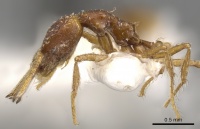Strumigenys formicosa
| Strumigenys formicosa | |
|---|---|

| |
| Scientific classification | |
| Kingdom: | Animalia |
| Phylum: | Arthropoda |
| Class: | Insecta |
| Order: | Hymenoptera |
| Family: | Formicidae |
| Subfamily: | Myrmicinae |
| Tribe: | Attini |
| Genus: | Strumigenys |
| Species: | S. formicosa |
| Binomial name | |
| Strumigenys formicosa Bolton, 2000 | |
Nothing is known about the biology of Strumigenys formicosa.
Identification
Bolton (2000) - A member of the Strumigenys precava-group. S. formicosa runs out in the key with those samples of Strumigenys precava that lack any trace of an intercalary tooth. Striking differences between the two species include the completely smooth lateral alitrunk in formicosa and its possession of a second, more proximal, preapical denticle that arises from the dorsal surface of the mandible. S. formicosa lacks the distinct long conical tubercle at the pronotal humerus that is characteristic of precava, and the latter also has a longer, narrower head, shorter mandibles and longer scapes that formicosa (compare measurements).
Keys including this Species
Distribution
Latitudinal Distribution Pattern
Latitudinal Range: -0.3094° to -0.4382°.
| North Temperate |
North Subtropical |
Tropical | South Subtropical |
South Temperate |
- Source: AntMaps
Distribution based on Regional Taxon Lists
Neotropical Region: Ecuador (type locality).
Distribution based on AntMaps
Distribution based on AntWeb specimens
Check data from AntWeb
Countries Occupied
| Number of countries occupied by this species based on AntWiki Regional Taxon Lists. In general, fewer countries occupied indicates a narrower range, while more countries indicates a more widespread species. |

|
Estimated Abundance
| Relative abundance based on number of AntMaps records per species (this species within the purple bar). Fewer records (to the left) indicates a less abundant/encountered species while more records (to the right) indicates more abundant/encountered species. |

|
Biology
Castes
Images from AntWeb

| |
| Paratype of Strumigenys formicosa. Worker. Specimen code casent0900444. Photographer Will Ericson, uploaded by California Academy of Sciences. | Owned by NHMUK, London, UK. |
Nomenclature
The following information is derived from Barry Bolton's Online Catalogue of the Ants of the World.
- formicosa. Strumigenys formicosa Bolton, 2000: 547 (w.) ECUADOR.
Unless otherwise noted the text for the remainder of this section is reported from the publication that includes the original description.
Description
Worker
Holotype. TL 3.1, HL 0.75, HW 0.64, CI 85, ML 0.53, MI 70, SL 0.50, SI 78, PW 0.34, AL 0.77. Apical fork of mandible without an intercalary tooth. Preapical dentition consists of a small acute tooth, very close to the apicodorsal tooth, and a more proximal small tooth or denticle that arises from the dorsal surface of the mandible; only the apex of this proximal tooth may break the outline of the inner margin. Upper scrobe margin bordered with a conspicuous lamina that at maximum is one-third or more the maximum width of the scape. Preocular impression in side of head extensive and deeply concave. Apicoscrobal hair flagellate. Cephalic dorsum with a pair of erect stiff hairs close to occipital margin. Pronotal humerus with a minute angular prominence from which a long flagellate hair arises. Mesonotum with a pair of flagellate hairs; petiole, postpetiole and especially first gastral tergite with long flagellate hairs. Dorsal alitrunk finely reticulate-punctate but may be partially effaced anteromedially on pronotum. Promesonotum without a median longitudinal carina. Dorsum of petiole node and disc of postpetiole smooth and shining. Entire side of alitrunk, including lateral pronotum, unsculptured, smooth and shining. Propodeal spines short, narrow and acute, subtended by a narrow lamella. Ventral surface of petiole without spongiform tissue from base to about level of spiracle, thereafter with a narrow spongiform strip that extends back beneath the node. Basigastral costulae shorter than length of postpetiole disc, first gastral tergite otherwise unsculptured.
Paratypes. TL 3.1-3.4, HL 0.75-0.79, HW 0.65-0.69, CI 85-87, ML 0.53-0.55, MI 69-72, SL 0.50, SI 72-77, PW 0.34-0.36, AL 0.78-0.84 (2 measured).
Type Material
Holotype worker, Ecuador: Provo Pichincha, Tinalandia, 16 km. SE Santo Domingo de los Colorados, 680 m., vi.1975, B-300 (S. & J. Peck) (Museum of Comparative Zoology).
Paratypes. 1 worker with same data as holotype; 1 worker Ecuador: Provo Pichincha, 3 km. E Tandapi, 1300 m., vi.1975, litter, wet ravine (S. & J. Peck) (The Natural History Museum, MCZ).
References
- Bolton, B. 2000. The ant tribe Dacetini. Mem. Am. Entomol. Inst. 65: 1-1028 (page 547, worker described)
References based on Global Ant Biodiversity Informatics
- Bolton, B. 2000. The Ant Tribe Dacetini. Memoirs of the American Entomological Institute 65
- Fernández, F. and S. Sendoya. 2004. Lista de las hormigas neotropicales. Biota Colombiana Volume 5, Number 1.

